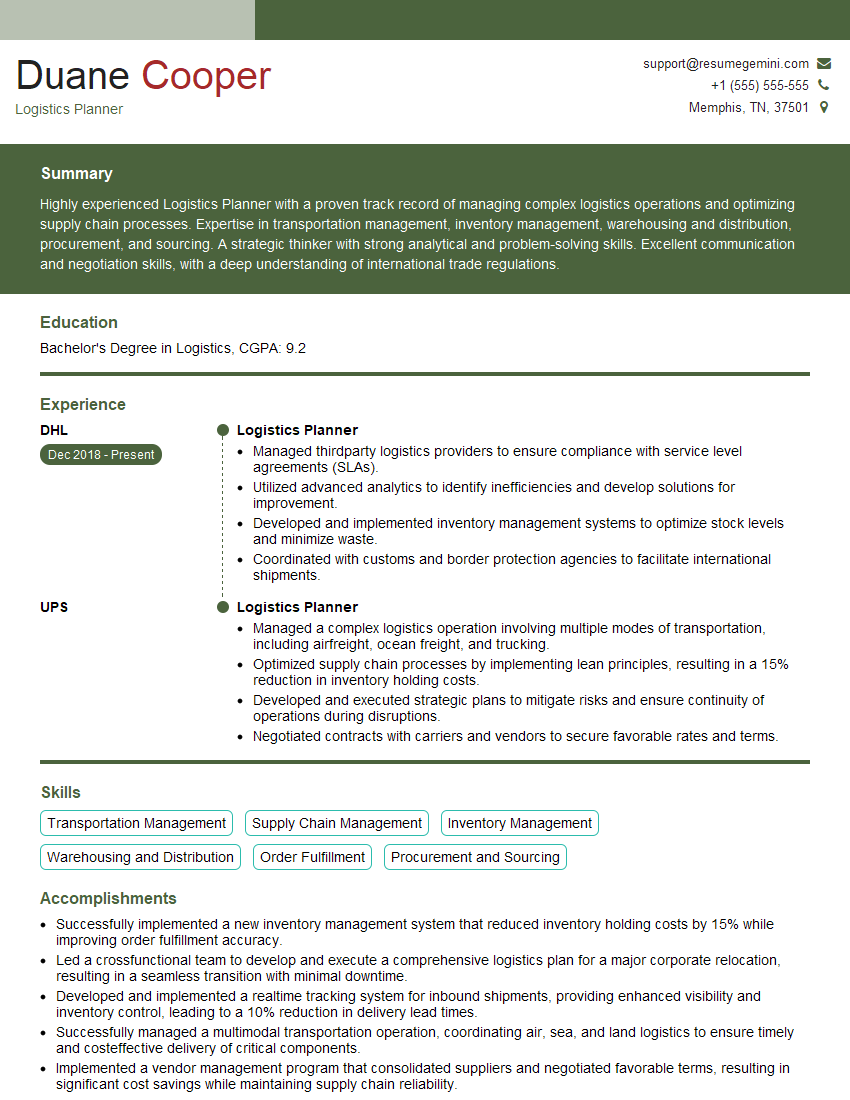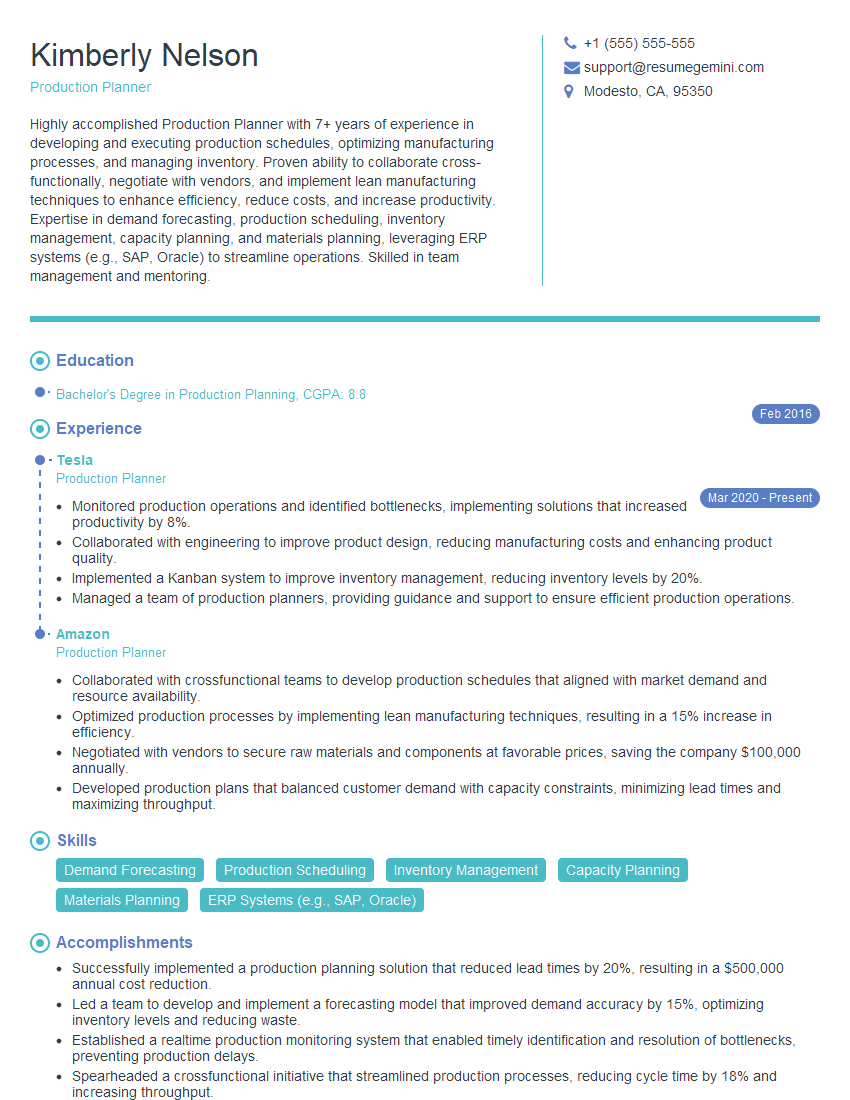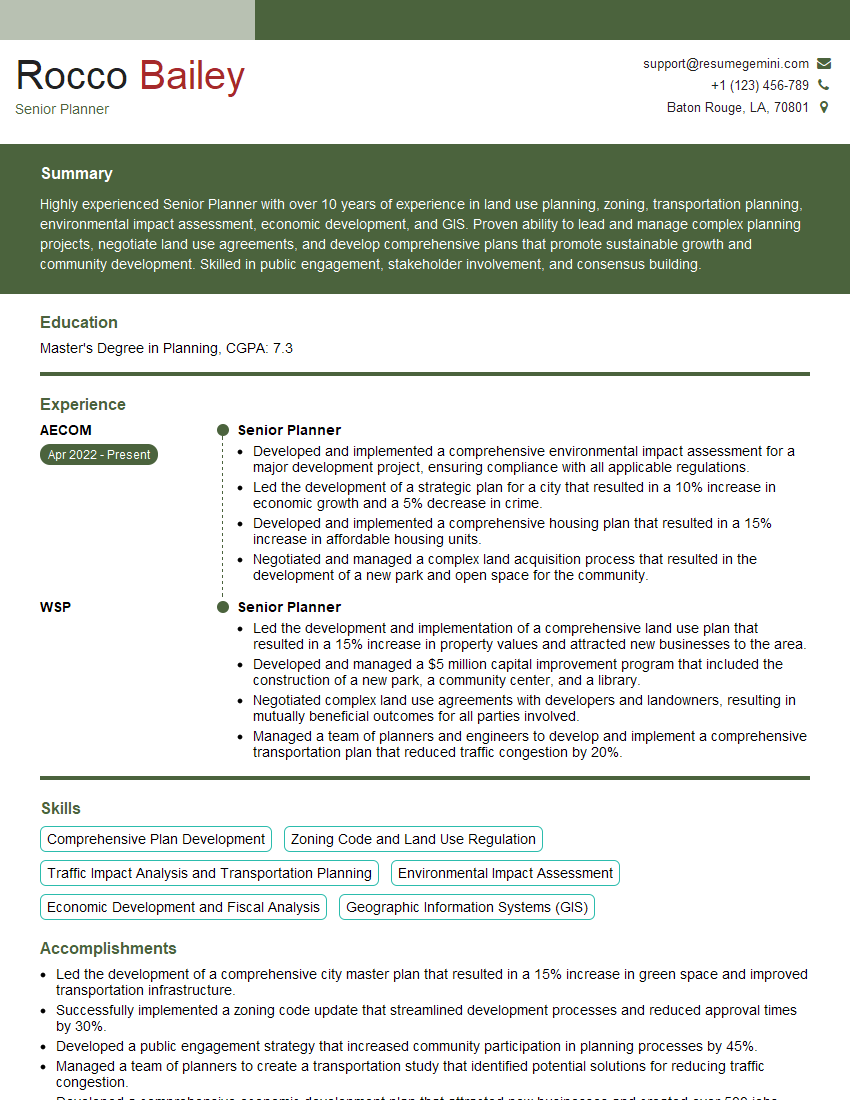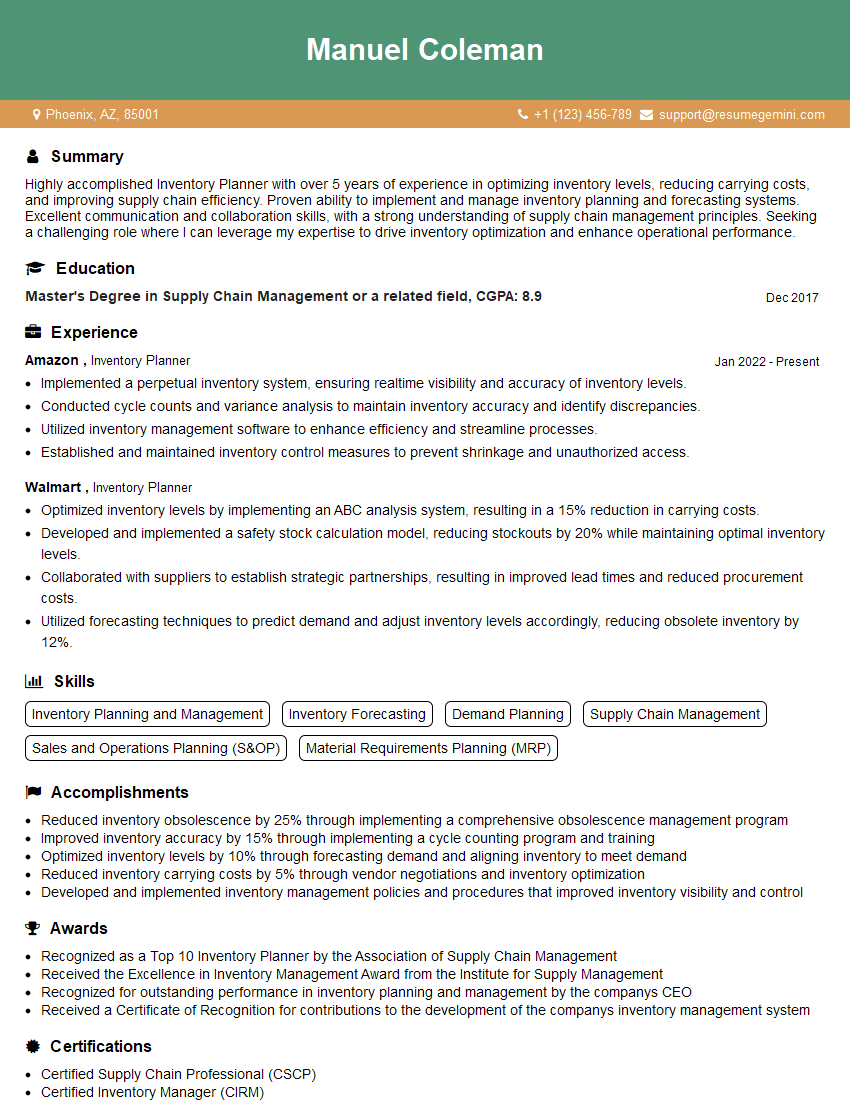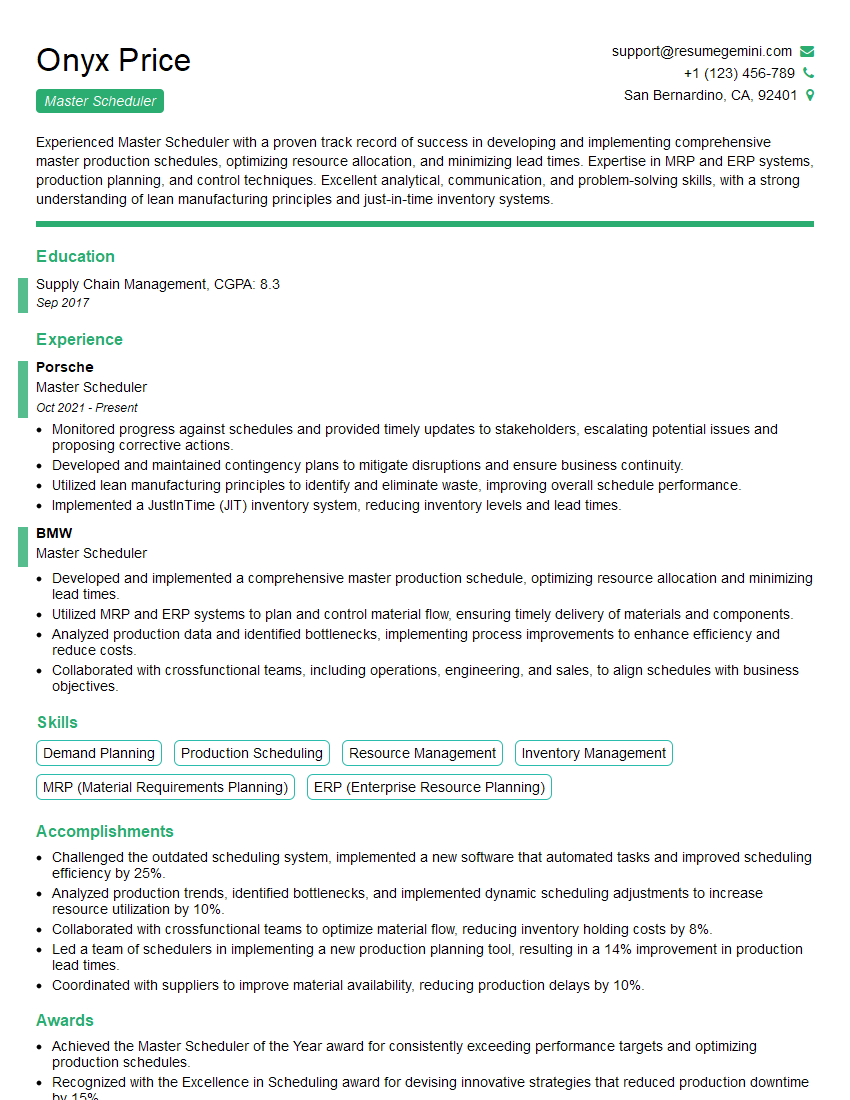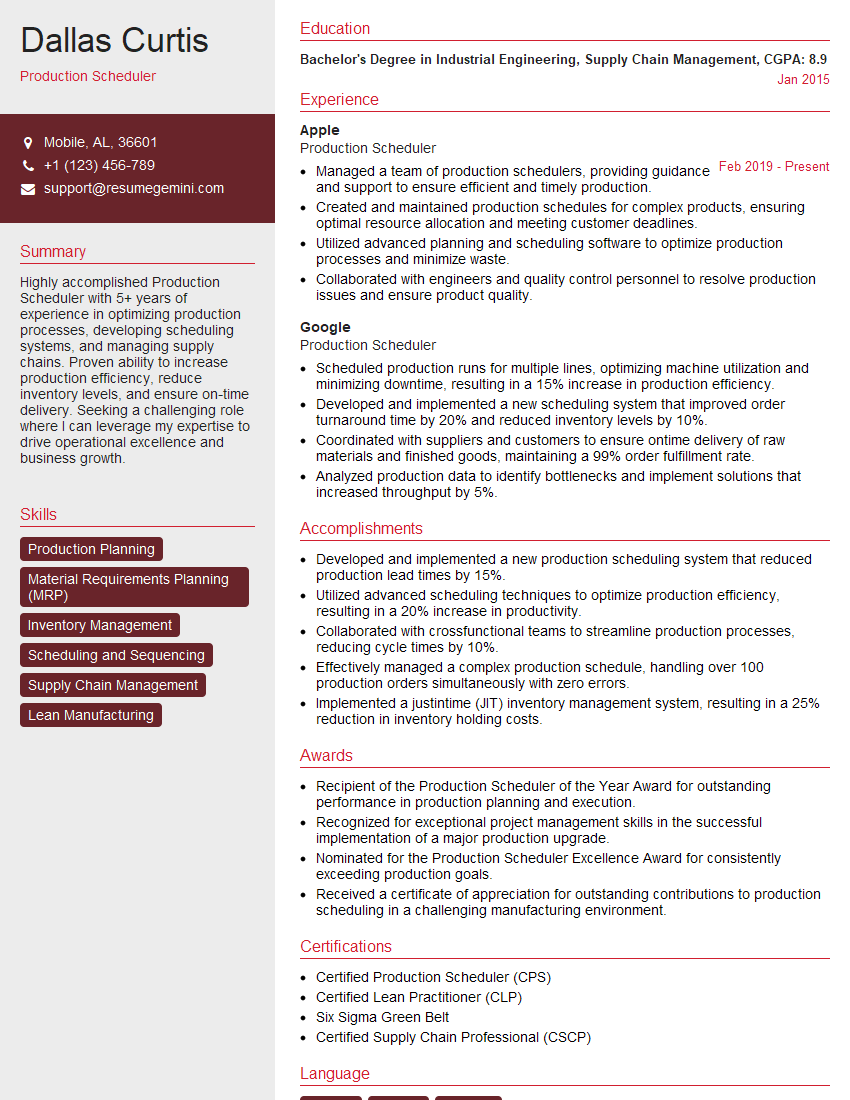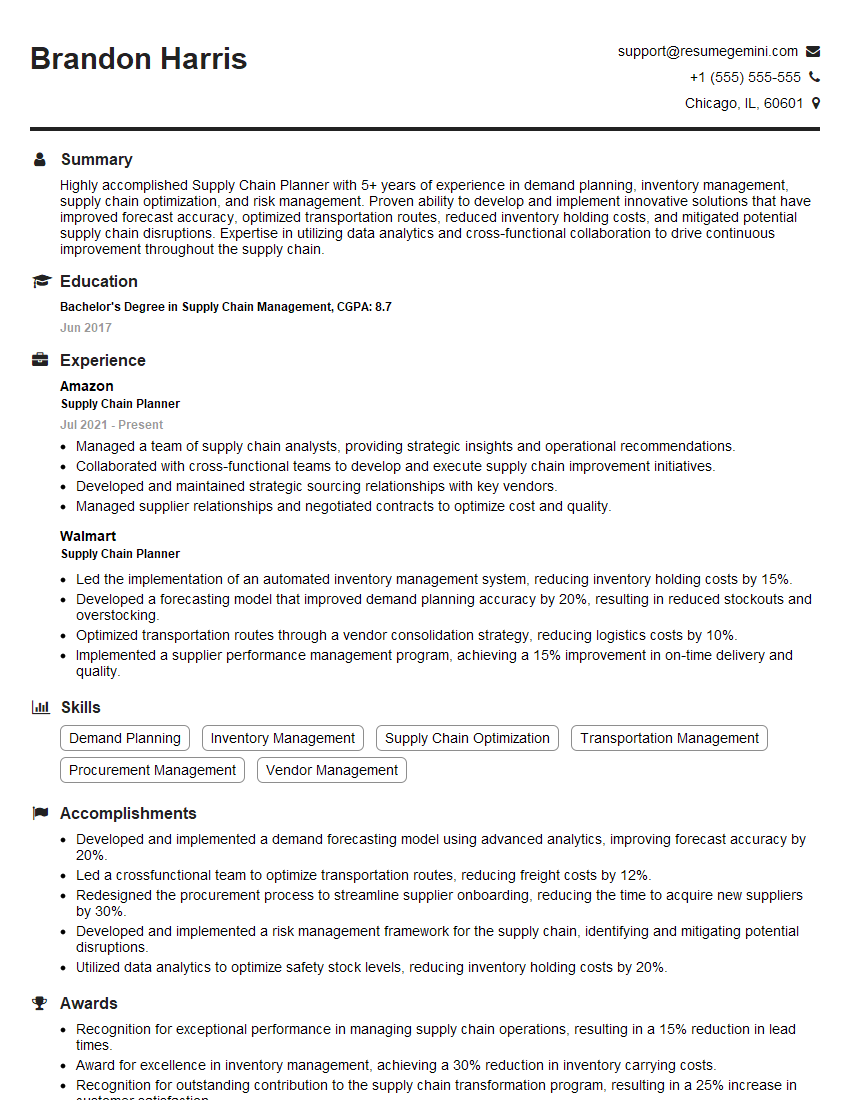Unlock your full potential by mastering the most common Process Planning and Scheduling interview questions. This blog offers a deep dive into the critical topics, ensuring you’re not only prepared to answer but to excel. With these insights, you’ll approach your interview with clarity and confidence.
Questions Asked in Process Planning and Scheduling Interview
Q 1. Explain the difference between forward scheduling and backward scheduling.
Forward scheduling and backward scheduling are two fundamental approaches to project scheduling, differing primarily in their starting point. Forward scheduling begins at the project’s start date and progresses forward, determining the earliest possible completion date for each task and the project as a whole. Backward scheduling, conversely, starts from the project’s due date and works backward, determining the latest allowable start date for each task to meet the overall deadline.
Forward Scheduling: Imagine building a house. You start with laying the foundation (Task 1), followed by framing (Task 2), then roofing (Task 3), and so on. Forward scheduling determines the earliest possible completion date for each stage, considering dependencies (you can’t roof before framing). The final completion date is the sum of all task durations.
Backward Scheduling: Now imagine you have a strict deadline for the house’s completion – say, a client moving-in date. Backward scheduling works from that date. You first determine the latest possible start date for the final task (interior finishing), then work backward to find the latest allowable start dates for all preceding tasks. Any delays in earlier tasks will directly impact the final completion date.
The choice between forward and backward scheduling depends on the project’s nature. Forward scheduling is ideal when flexibility is key and the focus is on understanding the earliest potential completion. Backward scheduling is crucial when deadlines are critical and resource allocation needs to be tightly managed to ensure timely project delivery.
Q 2. Describe your experience with different scheduling techniques (e.g., Gantt charts, critical path method).
I have extensive experience with various scheduling techniques, with Gantt charts and the Critical Path Method (CPM) being cornerstones of my approach. Gantt charts provide a visual representation of project schedules, showing tasks, durations, dependencies, and milestones. They’re excellent for communication and monitoring progress. I regularly use them to communicate project timelines to stakeholders and track task completion against the schedule.
The Critical Path Method is more analytical. It identifies the longest sequence of dependent tasks (the critical path) that determines the shortest possible project duration. Any delay on the critical path directly impacts the overall project completion. By understanding the critical path, I can prioritize resources and attention to those tasks, mitigating risks of project delays. In practice, I often combine Gantt charts with CPM analysis – the Gantt chart visually represents the entire schedule, while CPM highlights the crucial path requiring close management.
Beyond these, I have also utilized other techniques such as Program Evaluation and Review Technique (PERT), which accounts for task uncertainty by using probabilistic estimates for task durations, and resource leveling techniques, which adjust task schedules to balance resource utilization.
Q 3. How do you handle resource constraints during process planning?
Resource constraints are a common challenge in process planning. My approach to handling them involves a multi-pronged strategy that combines proactive planning with adaptive problem-solving. First, I conduct a thorough resource analysis to identify all available resources (personnel, equipment, materials) and their capacities. This analysis forms the basis of resource leveling or resource smoothing techniques.
Resource Leveling: This aims to distribute resource utilization more evenly over time, minimizing peaks and valleys. It involves adjusting task schedules within their flexibility margins to avoid over-allocation. Think of it as optimizing worker schedules to ensure consistent workload across the project lifecycle rather than overwhelming them during specific periods.
Resource Smoothing: This technique tries to level resource usage while keeping the project’s overall duration as short as possible. The key difference is that task durations are not changed; only their scheduling is adjusted.
If resource constraints still remain after these techniques, I explore other options such as: outsourcing certain tasks, procuring additional resources (e.g., renting extra equipment), or adjusting the project scope (prioritizing critical tasks). The decision depends on the specific project’s context and the relative costs and benefits of each option.
Q 4. Explain your experience with capacity planning and resource allocation.
Capacity planning and resource allocation are intertwined aspects of efficient process planning. Capacity planning involves determining the overall production capacity needed to meet demand, considering factors such as equipment capacity, labor availability, and material supply. Resource allocation then involves distributing those available resources across various tasks or projects to optimize overall efficiency.
My experience includes using various techniques like what-if analysis to model the impact of different resource allocation scenarios. This lets us explore options before implementing them. I also employ forecasting techniques to predict future demand and adjust capacity accordingly. For instance, anticipating seasonal spikes in demand allows for proactive resource adjustments to prevent bottlenecks.
In a past project, we used linear programming to optimize resource allocation across multiple manufacturing lines. By considering production costs, machine capabilities, and due dates, we were able to achieve significant efficiency gains and reduce production times.
Q 5. Describe a time you had to optimize a production process. What was the outcome?
In a previous role, we were struggling with bottlenecks in our packaging line, leading to significant delays and increased costs. The original process was linear, with each step dependent on the previous one. A single machine’s failure could halt the entire line.
To optimize, we implemented a parallel processing strategy. We reorganized the packaging stages, allowing multiple steps to occur simultaneously, reducing the impact of individual machine downtime. We also integrated a system for real-time monitoring, enabling us to identify and address potential bottlenecks immediately. The result was a 25% reduction in packaging time, a 15% decrease in labor costs, and a significant improvement in product delivery times.
Q 6. How do you measure the effectiveness of a process planning strategy?
Measuring the effectiveness of a process planning strategy relies on a set of key performance indicators (KPIs) aligned with project goals. These KPIs can be broadly categorized into:
- Time-related metrics: Project completion time, cycle time, lead time, and adherence to schedule.
- Cost-related metrics: Total project cost, cost per unit, and cost overruns.
- Quality-related metrics: Defect rates, rework rates, and customer satisfaction.
- Resource utilization: Efficiency of resource utilization, machine downtime, and personnel productivity.
By tracking these metrics, we can assess the effectiveness of our process planning strategies and identify areas for improvement. Data analysis and regular performance reviews are crucial to inform adjustments and refinements.
Q 7. How familiar are you with different software for process planning and scheduling (e.g., MS Project, Primavera P6)?
I am proficient in several software packages for process planning and scheduling. MS Project is a familiar tool for managing projects, creating Gantt charts, assigning resources, and tracking progress. I have utilized its features extensively for projects of various sizes and complexities. Primavera P6 offers more advanced capabilities, particularly useful for large-scale, complex projects requiring intricate resource management and detailed scheduling. I have worked with Primavera P6 on projects requiring detailed cost analysis and risk management integrations.
Beyond these, I have experience with other specialized software, adapting my skills to the specific tools required by a project. My familiarity extends to tools that handle material requirements planning (MRP), enterprise resource planning (ERP) systems, and specialized simulation software for process optimization.
Q 8. How do you incorporate risk management into your process planning?
Risk management in process planning isn’t about avoiding risks entirely—it’s about identifying, assessing, and mitigating them to minimize their impact. Think of it like a weather forecast for your project; you can’t control the storm, but you can prepare for it.
- Identification: We start by brainstorming potential problems. This could include supplier delays, equipment malfunctions, changes in demand, or even employee absences. We use techniques like Failure Mode and Effects Analysis (FMEA) to systematically identify potential failure points and their consequences.
- Assessment: Once identified, we assess the likelihood and severity of each risk. A simple risk matrix can be used, plotting likelihood against impact to prioritize which risks require the most attention.
- Mitigation: This is where we develop strategies to reduce the likelihood or impact of the risks. For example, for a supplier delay, we might diversify our suppliers or build in extra lead time. For equipment malfunction, we might implement a preventative maintenance program.
- Monitoring and Control: Throughout the project, we continuously monitor the risks and update our mitigation plans as needed. Regular project reviews are crucial for identifying emerging risks.
For example, in a manufacturing setting, if we anticipate a potential shortage of a key raw material, we’d explore alternative suppliers, build a safety stock, or explore substitute materials—all to mitigate the risk of production delays.
Q 9. Explain your understanding of Lean principles and their application in process planning.
Lean principles focus on eliminating waste and maximizing value for the customer. In process planning, this translates to streamlining processes, reducing lead times, and improving efficiency. Think of it as removing all the unnecessary steps in a recipe to make a delicious meal faster and more effectively.
- Value Stream Mapping: We use this to visually represent the entire process, from beginning to end, identifying areas of waste (e.g., waiting, transportation, inventory).
- 5S Methodology: This promotes a clean, organized, and efficient workspace, reducing waste and improving productivity. It’s about sorting, setting in order, shining, standardizing, and sustaining.
- Kaizen (Continuous Improvement): We foster a culture of continuous improvement, where small, incremental changes are made regularly to optimize processes.
- Just-in-Time (JIT) Inventory: We aim to have only the necessary materials at the right time, minimizing storage costs and reducing waste.
For example, in a car manufacturing plant, lean principles might lead to a reduction in the number of parts in inventory, a more efficient assembly line, and improved communication between departments, ultimately reducing lead time and improving customer satisfaction.
Q 10. How do you handle unexpected delays or disruptions in a production schedule?
Unexpected delays are inevitable. The key is having a plan in place to handle them effectively. Imagine a highway detour—you need alternative routes to reach your destination.
- Identify the root cause: First, we thoroughly investigate the reason for the delay. Was it equipment failure, material shortage, or something else?
- Assess the impact: How will this delay affect the overall project schedule and deliverables?
- Develop a recovery plan: This could involve re-allocating resources, adjusting priorities, negotiating with suppliers, or implementing overtime. Critical Path Method (CPM) analysis can help identify tasks most impacted.
- Communicate the changes: Keep all stakeholders informed about the delay and the recovery plan. Transparency is crucial.
- Learn from the experience: Analyze what caused the delay to prevent similar incidents in the future. Perhaps improved preventative maintenance would have avoided the equipment failure.
In a software development project, if a key component is delayed, we might re-prioritize tasks, focus on other independent modules, and communicate the revised timeline to clients.
Q 11. How do you ensure effective communication and collaboration within a planning team?
Effective communication and collaboration are paramount in process planning. Think of it as a well-orchestrated symphony—everyone needs to be on the same page to produce beautiful music.
- Regular Meetings: Consistent meetings (daily stand-ups, weekly progress reviews) keep everyone informed.
- Collaborative Tools: Utilizing project management software (e.g., Jira, Asana) facilitates information sharing and task management.
- Clear Roles and Responsibilities: Each team member should have a well-defined role and understand their responsibilities to avoid confusion and overlap.
- Open Communication Channels: Encourage open dialogue and feedback among team members. Establish clear channels for escalating issues.
- Conflict Resolution: Develop mechanisms for addressing disagreements and conflicts constructively.
For example, using a shared online calendar for scheduling meetings and a project management tool to track progress ensures everyone is aware of deadlines and potential conflicts.
Q 12. Describe your experience with demand forecasting and its impact on process planning.
Demand forecasting is predicting future demand for a product or service. It’s like predicting the weather to plan for your outdoor events. Accurate forecasting significantly impacts process planning, enabling us to optimize resource allocation and avoid bottlenecks.
- Data Analysis: We use historical sales data, market trends, economic indicators, and even social media sentiment to develop forecasts.
- Forecasting Techniques: Various techniques are used, including moving averages, exponential smoothing, and time series analysis. The choice depends on the data and the desired accuracy.
- Scenario Planning: We often create multiple scenarios (best-case, worst-case, most likely) to anticipate different possibilities.
- Impact on Planning: Accurate forecasts allow for better inventory management, efficient staffing levels, and optimized production schedules.
For example, if demand forecasting suggests a significant increase in sales during the holiday season, we can adjust our production schedule accordingly, ensure sufficient inventory, and hire additional temporary staff.
Q 13. How do you balance the need for efficiency with the need for quality in process planning?
Balancing efficiency and quality is a crucial aspect of process planning. It’s like finding the sweet spot between speed and flavor in cooking—you need both to create a great dish.
- Define Quality Standards: Clearly defining quality standards and metrics helps ensure consistent quality throughout the process.
- Process Optimization: Streamlining processes while adhering to quality standards improves both efficiency and quality. This might involve automation or improved workflows.
- Quality Control Measures: Implementing regular quality checks and inspections throughout the process helps identify and correct defects early.
- Continuous Improvement: Continuously analyzing the process for areas of improvement allows for enhancements in both efficiency and quality.
For instance, in a pharmaceutical company, maintaining high quality standards is paramount. While efficiency is important, compromising quality to meet deadlines is unacceptable. We carefully balance the two by implementing rigorous quality control checks at each stage of the manufacturing process, even though this might increase production time slightly.
Q 14. Explain your understanding of bottleneck analysis and how you address it.
Bottleneck analysis identifies constraints that limit the overall throughput of a process. It’s like finding the narrowest part of a funnel—that’s where the flow is restricted. Addressing bottlenecks is key to improving overall efficiency.
- Identify Bottlenecks: We use techniques like Little’s Law or process mapping to identify the stages with the longest processing times or highest work-in-progress (WIP) inventory.
- Analyze the Causes: Why is this stage a bottleneck? Is it due to equipment limitations, inefficient processes, or skilled labor shortages?
- Develop Solutions: Solutions might include upgrading equipment, improving process design, adding resources (staff, machinery), or outsourcing certain tasks.
- Implement and Monitor: Once implemented, we monitor the impact of the changes and make further adjustments as needed.
In a restaurant, the bottleneck might be the slow speed of the kitchen staff. Addressing this could involve investing in better equipment, optimizing kitchen workflows, or hiring additional cooks. This will allow more orders to be filled and increase efficiency.
Q 15. How do you use data analytics to improve process planning and scheduling?
Data analytics plays a crucial role in optimizing process planning and scheduling. By analyzing historical data, we can identify bottlenecks, predict demand fluctuations, and ultimately create more efficient processes. This involves leveraging various techniques.
- Predictive Analytics: Using historical data on production times, machine downtime, and material consumption, we can build predictive models to forecast future performance and potential issues. For example, if we notice a consistent spike in machine failures every Tuesday afternoon, we can schedule preventative maintenance to avoid production delays.
- Process Mining: This technique analyzes event logs from existing processes to visualize the ‘as-is’ state and identify deviations from the planned process. This allows for targeted improvements by pinpointing areas of inefficiency. For instance, process mining might reveal unnecessary steps in a manufacturing process, leading to streamlined workflows.
- Simulation: Simulation software allows us to test different scheduling scenarios and process configurations before implementing them in the real world. This minimizes risk and helps us optimize resource allocation. We can simulate the impact of adding another machine or changing the sequence of operations to determine the best approach.
By combining these approaches, we can create data-driven process plans and schedules that are more robust and adaptable to changing conditions.
Career Expert Tips:
- Ace those interviews! Prepare effectively by reviewing the Top 50 Most Common Interview Questions on ResumeGemini.
- Navigate your job search with confidence! Explore a wide range of Career Tips on ResumeGemini. Learn about common challenges and recommendations to overcome them.
- Craft the perfect resume! Master the Art of Resume Writing with ResumeGemini’s guide. Showcase your unique qualifications and achievements effectively.
- Don’t miss out on holiday savings! Build your dream resume with ResumeGemini’s ATS optimized templates.
Q 16. What are the key performance indicators (KPIs) you use to monitor process performance?
Key Performance Indicators (KPIs) are essential for monitoring process performance. The specific KPIs will vary depending on the industry and the specific process, but some common ones include:
- On-Time Delivery (OTD): Measures the percentage of orders delivered on or before the scheduled date. A high OTD rate indicates effective scheduling and efficient processes.
- Throughput: The rate at which the process produces output. For example, units produced per hour or per day. Increasing throughput usually signifies improved efficiency.
- Cycle Time: The time it takes for a product or service to move through the entire process. Reducing cycle time is a critical goal in lean manufacturing.
- Inventory Turnover: The number of times inventory is sold or used during a specific period. Higher turnover generally indicates efficient inventory management.
- Defect Rate: The percentage of defective products or services produced. A low defect rate reflects a well-controlled process.
- Machine Utilization: The percentage of time a machine is actively producing. High utilization indicates efficient resource allocation, though it’s important to balance this with preventative maintenance.
Regularly monitoring these KPIs allows us to identify areas for improvement and measure the effectiveness of implemented changes.
Q 17. How do you prioritize tasks and projects within a complex production schedule?
Prioritizing tasks and projects in a complex production schedule requires a structured approach. I typically use a combination of techniques:
- Critical Path Method (CPM): This technique identifies the sequence of tasks that determines the shortest possible duration of the project. By focusing on tasks along the critical path, we can ensure timely completion.
- Dependency Analysis: Understanding the dependencies between tasks (e.g., task A must be completed before task B can begin) is essential for effective scheduling. This helps avoid conflicts and delays.
- Prioritization Matrices: Tools like Eisenhower Matrix (Urgent/Important) help classify tasks based on urgency and importance, allowing for effective prioritization. High-impact, high-urgency tasks get immediate attention.
- Resource Allocation: Considering the availability of resources (machines, personnel, materials) is crucial. Tasks requiring scarce resources may need to be prioritized or scheduled strategically.
In practice, this often involves using project management software to visualize dependencies, track progress, and manage resource allocation. Regular review meetings and adjustments are crucial to adapt to unforeseen circumstances.
Q 18. Explain your experience with different inventory management techniques.
My experience encompasses several inventory management techniques, each suited to different contexts:
- Just-in-Time (JIT): This system aims to minimize inventory by receiving materials only when needed for production. It reduces storage costs and minimizes waste but requires precise forecasting and strong supplier relationships. I implemented JIT successfully in a manufacturing environment, resulting in a significant reduction in warehouse space and inventory costs.
- Economic Order Quantity (EOQ): EOQ models determine the optimal order quantity to minimize total inventory costs (holding costs and ordering costs). I’ve used EOQ calculations to optimize inventory levels for slow-moving items.
- Material Requirements Planning (MRP): MRP is a system for planning and controlling materials required for production. It considers lead times, bill of materials, and inventory levels to schedule material procurement. I’ve used MRP extensively in complex manufacturing projects to ensure timely availability of parts and components.
- Kanban: This visual system signals the need for replenishment of materials or work-in-progress. I’ve found Kanban effective in lean manufacturing environments for managing workflow and reducing lead times.
The choice of technique depends on factors like demand variability, lead times, storage costs, and the complexity of the product or service.
Q 19. How do you develop and maintain accurate schedules?
Developing and maintaining accurate schedules requires a combination of planning, communication, and monitoring. My approach involves:
- Detailed Task Breakdown: Breaking down the project into smaller, manageable tasks, estimating the time required for each.
- Resource Capacity Planning: Considering the available resources (personnel, equipment, materials) and their capacity to handle the workload.
- Scheduling Software: Utilizing project management software to create and visualize the schedule, track progress, and manage dependencies.
- Regular Monitoring and Adjustments: Continuously monitoring progress, identifying deviations from the plan, and making necessary adjustments to keep the schedule on track. This often involves daily stand-up meetings and progress reports.
- Communication and Collaboration: Maintaining open communication with all stakeholders to ensure everyone is aware of the schedule and any changes.
- Contingency Planning: Incorporating buffer time to account for unforeseen delays or challenges.
Accuracy is crucial; inaccuracies lead to delays, cost overruns, and dissatisfied customers. A well-defined process and meticulous attention to detail are key to success.
Q 20. How do you ensure that your process planning aligns with overall business objectives?
Aligning process planning with overall business objectives is paramount. This requires a holistic approach that considers the strategic goals of the organization.
- Strategic Alignment: Clearly defining the business objectives, such as increasing market share, improving profitability, or enhancing customer satisfaction.
- Process Mapping: Developing detailed process maps to visualize how different processes contribute to achieving business objectives.
- KPI Alignment: Ensuring that the KPIs used to monitor process performance directly reflect the business objectives. For instance, if a business objective is to reduce lead times, then cycle time becomes a critical KPI.
- Resource Allocation: Allocating resources (budget, personnel, equipment) to processes that directly support the achievement of business objectives.
- Continuous Improvement: Regularly reviewing the effectiveness of processes and making necessary adjustments to ensure continued alignment with evolving business objectives.
In essence, process planning should not be an isolated activity but an integral part of the organization’s strategic planning process. By linking process improvements to tangible business outcomes, we ensure that the work delivers real value.
Q 21. Describe your experience with project management methodologies (e.g., Agile, Waterfall).
I have extensive experience with both Agile and Waterfall project management methodologies, and my choice depends heavily on the project’s nature and requirements.
- Waterfall: This is a linear approach where each phase (requirements, design, implementation, testing, deployment) must be completed before moving to the next. It’s well-suited for projects with well-defined requirements and minimal anticipated changes. I’ve successfully used Waterfall in projects with fixed scope and timelines, such as implementing a new ERP system.
- Agile: This iterative approach emphasizes flexibility and collaboration. Projects are broken down into smaller iterations (sprints), with frequent feedback loops and adaptations. Agile is ideal for projects with evolving requirements or a need for rapid prototyping. I’ve led Agile teams in software development projects, where the ability to adapt to changing user needs was critical for success.
In some cases, a hybrid approach—combining elements of both Agile and Waterfall—can be the most effective. The key is to select the methodology best suited to the specific project context and team capabilities.
Q 22. How do you handle conflicts between different departments or stakeholders during process planning?
Handling inter-departmental conflicts during process planning requires a collaborative and structured approach. It’s not just about finding a compromise; it’s about aligning everyone’s goals with the overall objective. I begin by facilitating a meeting involving all stakeholders. This isn’t a negotiation session; it’s a collaborative problem-solving session. We start by clearly defining the project goals and desired outcomes. Then, each department presents their perspectives, constraints, and potential roadblocks. I use visual aids like flowcharts or Gantt charts to illustrate the interconnectedness of each department’s contribution to the overall process. This helps identify points of conflict early on. Once all perspectives are understood, we brainstorm solutions together, seeking creative ways to resolve the conflicts. This often involves prioritizing tasks, reallocating resources, or adjusting deadlines. The key is open communication, active listening, and a commitment from all parties to find mutually beneficial solutions. For example, in a recent project involving manufacturing and marketing, a conflict arose over packaging timelines. Marketing wanted faster turnaround for promotional campaigns, conflicting with manufacturing’s capacity constraints. Through collaborative discussions and a compromise involving phased rollouts and prioritized product lines, we resolved the conflict without compromising quality or timelines.
Q 23. How do you ensure that your process plans are flexible and adaptable to change?
Flexibility and adaptability are paramount in process planning. Rigid plans often fail to account for the inevitable unforeseen circumstances. To build flexibility, I incorporate several key strategies. Firstly, I utilize modular process design. This involves breaking down the process into smaller, independent modules. This allows for easier modification or replacement of individual modules without disrupting the entire process. Secondly, I build in buffer times and capacity within the schedule. This provides a cushion to absorb unexpected delays or increased workload. Thirdly, I actively monitor the process and use real-time data to identify deviations from the plan. This proactive monitoring allows for early intervention and adjustment. Finally, I use agile methodologies where appropriate. Regular reviews and adjustments to the plan based on feedback and performance data ensure the plan remains relevant and responsive to change. For instance, in a project involving software development, we used Scrum methodology to adjust sprints based on feedback and changing priorities, ensuring adaptability without compromising the final product quality.
Q 24. How familiar are you with different types of production planning systems (e.g., MRP, ERP)?
I am proficient with various production planning systems, including Material Requirements Planning (MRP) and Enterprise Resource Planning (ERP). MRP systems are crucial for managing inventory and ensuring timely procurement of materials. I understand its core components, including the bill of materials (BOM), master production schedule (MPS), and inventory records. I’ve used MRP systems to optimize inventory levels, reduce lead times, and minimize waste. ERP systems, on the other hand, offer a more holistic view of the entire business, integrating various aspects like finance, human resources, and supply chain management. I am familiar with the modules relevant to process planning and scheduling within ERP systems, such as production planning, capacity management, and shop floor control. The choice between MRP and ERP depends on the scale and complexity of the operation. Smaller businesses may find MRP sufficient, while larger organizations benefit from the integrated capabilities of an ERP system. I have practical experience with both systems and can adapt my approach to leverage the strengths of each based on the specific needs of a project.
Q 25. Describe your experience with implementing new process planning strategies.
Implementing new process planning strategies requires a phased approach. I start by conducting a thorough assessment of the existing processes, identifying bottlenecks, inefficiencies, and areas for improvement. This involves data analysis, process mapping, and stakeholder interviews. Next, I design the new strategy, selecting the appropriate tools and techniques based on the specific needs and goals. This may involve introducing new technologies, reorganizing workflows, or retraining personnel. The implementation phase is crucial, requiring careful planning and execution. I focus on change management, communicating the benefits of the new strategy to all stakeholders, and providing training and support to the teams involved. Finally, I establish a robust monitoring and evaluation system to track progress, identify any issues, and make necessary adjustments. In one project, we implemented Lean manufacturing principles to streamline a manufacturing process. This involved mapping the value stream, eliminating waste, and empowering employees to identify and solve problems. The result was a significant reduction in lead times and an increase in productivity. Success depends not only on the technical aspects but also on effective communication and change management.
Q 26. How do you stay up-to-date with the latest trends and best practices in process planning and scheduling?
Staying updated in this dynamic field is crucial. I achieve this through a combination of approaches. I actively participate in industry conferences and workshops, networking with peers and learning about the latest advancements. I subscribe to relevant industry publications and journals to stay informed about new research and best practices. Online learning platforms offer valuable courses and certifications, allowing for continuous professional development. I also regularly review case studies and success stories from different industries to understand how others are solving similar challenges. Furthermore, I actively participate in online communities and forums dedicated to process planning and scheduling, exchanging ideas and insights with other professionals. This multi-faceted approach ensures I remain current with the latest trends and best practices, always looking for ways to improve my skills and knowledge.
Q 27. What are some common challenges in process planning and how do you overcome them?
Common challenges in process planning include inaccurate data, lack of stakeholder buy-in, unforeseen disruptions, and resistance to change. Inaccurate data can lead to flawed planning and scheduling, resulting in delays and inefficiencies. I address this by implementing robust data collection and validation processes. Lack of stakeholder buy-in can hinder implementation. I overcome this through effective communication, collaboration, and demonstrating the benefits of the new strategy. Unforeseen disruptions, such as equipment failures or supply chain issues, are inevitable. I mitigate this by building buffer times into the schedule and developing contingency plans. Finally, resistance to change is a common human factor. I address this through change management strategies, providing training and support, and emphasizing the benefits of the new process for employees. The key to overcoming these challenges lies in proactive planning, effective communication, and a flexible approach.
Q 28. How would you approach optimizing a manufacturing process with multiple production lines?
Optimizing a manufacturing process with multiple production lines requires a holistic approach. I would begin by analyzing the overall production capacity of each line, considering factors like machine speed, uptime, and workforce availability. Then, I’d map the workflow across all lines, identifying bottlenecks and areas where improvements can be made. This often involves using simulation software to model different scenarios and identify potential improvements. Furthermore, I would analyze the product mix and demand forecasting to ensure that the production lines are efficiently allocated to meet customer demands. This may involve adjusting line configurations, optimizing scheduling algorithms, or implementing just-in-time (JIT) inventory management. I’d also look for opportunities to improve material flow between lines and minimize unnecessary transportation. Data analytics plays a crucial role in identifying trends, patterns, and areas of improvement. Regular monitoring and adjustment of the production plan based on real-time data are essential to ensure optimal performance. Ultimately, optimization involves a combination of technological solutions and process improvement techniques tailored to the specific manufacturing environment.
Key Topics to Learn for Process Planning and Scheduling Interview
- Process Mapping and Flowcharting: Understanding different process mapping techniques (e.g., SIPOC, Value Stream Mapping) and their application in identifying bottlenecks and inefficiencies. Practical application: Analyzing a manufacturing process to optimize throughput.
- Scheduling Techniques: Mastering various scheduling methodologies (e.g., Gantt charts, Critical Path Method (CPM), Program Evaluation and Review Technique (PERT)). Practical application: Developing a project schedule with resource allocation and dependency management.
- Capacity Planning: Assessing resource capacity, predicting demand, and optimizing resource allocation to meet production targets. Practical application: Determining the optimal number of machines needed for a given production volume.
- Lean Manufacturing Principles: Understanding and applying lean principles (e.g., Kaizen, 5S) to eliminate waste and improve efficiency in process planning and scheduling. Practical application: Implementing a Kanban system to manage workflow.
- Supply Chain Management Integration: Understanding how process planning and scheduling impacts the broader supply chain, including procurement, inventory management, and logistics. Practical application: Optimizing inventory levels to minimize holding costs while ensuring timely delivery.
- Performance Measurement and Metrics: Defining and tracking key performance indicators (KPIs) to monitor process effectiveness and identify areas for improvement. Practical application: Tracking lead times, cycle times, and on-time delivery rates.
- Software and Tools: Familiarity with common process planning and scheduling software (mentioning specific software is optional, focus on understanding the functionalities instead). Practical application: Using software to simulate different scheduling scenarios and optimize resource allocation.
- Problem-Solving Methodologies: Applying root cause analysis techniques (e.g., 5 Whys, Fishbone diagrams) to identify and resolve process inefficiencies. Practical application: Troubleshooting production delays and identifying the root causes.
Next Steps
Mastering Process Planning and Scheduling is crucial for career advancement in operations management, supply chain, and project management. It demonstrates your ability to streamline processes, optimize resource utilization, and improve overall efficiency—highly valued skills in today’s competitive job market. To significantly boost your job prospects, create an ATS-friendly resume that showcases your skills effectively. ResumeGemini is a trusted resource that can help you build a professional, impactful resume. Examples of resumes tailored to Process Planning and Scheduling are available to guide you.
Explore more articles
Users Rating of Our Blogs
Share Your Experience
We value your feedback! Please rate our content and share your thoughts (optional).
What Readers Say About Our Blog
Hi, I’m Jay, we have a few potential clients that are interested in your services, thought you might be a good fit. I’d love to talk about the details, when do you have time to talk?
Best,
Jay
Founder | CEO


